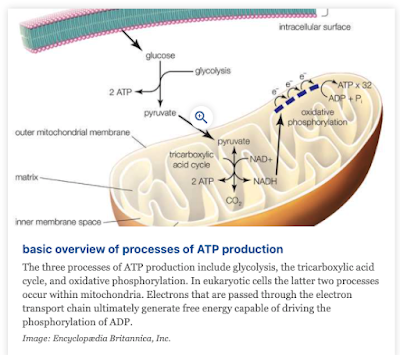Where are we going with this? The information on this page should increase understanding related to this standard: Evaluate comparative models of various cell type…Evaluate eukaryotic and prokaryotic cells.
Adenosine Triphosphate-Cellular Energy
(So… We're really doing this?)
 |
| https://www.britannica.com/science/adenosine-triphosphate |
In animals, the mitochondrion creates it…
…in the form of adenosine triphosphate (ATP). It's actually a fairly easy concept, although the bio-chemistry behind it is fairly detailed. (Promises, promises!)
In plants, "ATP is synthesized in the thylakoid membrane of the chloroplast. The process is called photophosphorylation. The "machinery" is similar to that in mitochondria except that light energy is used to pump protons across a membrane to produce a proton-motive force" (Source 2021-10)
Cells need energy for a number of different functions (e.g. cell metabolism, transportation across membranes, moving muscles).
Energy in cells is stored as lipids (fats) and is made ready for use as carbohydrates (sugars). The ready-to-use sugars, however, are further processed into ATP by the mitochondrion. "ATP then serves as a shuttle, delivering energy to places within the cell where energy-consuming activities are taking place" [1].
ATP has two main parts:
The first part is the adenosine part. Adenosine is made of the nitrogenous base, adenine plus a sugar called ribose.
The triphosphate part is made of… three phosphates in a chain.
It is this phosphate chain wherein the energy is stored.
Before we go any further, let's define some things.
ATP = adenosine triphosphate: an adenosine + 3 phosphatesADP = adenosine diphosphate: an adenosine + 2 phosphatesAMP = adenosine monophosphate: an adenosine + 1 phosphateand remember that adenosine is made of the nitrogenous base, adenine plus a sugar called ribose
So… what happens is this…
It's actually a cycle in which ATP gives off energy to become ADP or (sometimes AMP) and then later, becomes ATP again.
In the mitochondria, ATP is formed, and then shipped out to the cell to do some work. Where work needs to be done, one of the phosphates is broken off from the ATP.
Since energy is stored in chemical bonds and since the phosphate bond has a relatively impressive bonding energy, the breaking of the phosphate bond gives off a lot of energy—energy that the cell needs for the various functions mentioned earlier.
 |
| https://www.biologyonline.com/tutorials/biological-energy-adp-atp |
The ATP --> ADP --> ATP --> ADP… cycle goes on and one. (Likewise, if it's a case of breaking two bonds to become AMP, it's a cycle.)
To say it another way…
…sugar gets "burned" to provide energy to jam a phosphate onto an ADP making it an ATP.
…ATP goes out into the cell from the mitochondria.
…one of the phosphate bonds breaks releasing energy to power cell functioning.
…repeat
That's it… As a quick look, this is how ATP serves as the source of energy for cells.
Granted, this leaves out a LOT of details. More can be learned from the linked resources and many, many others.
Sources and more information…
No comments:
Post a Comment